mobile View, to the German Version tap the flag


- Republic of Nauru
- presidial republic with initial stages of parliamentarism
- own name: Naoero
• Flag
• Historical Flags
• Meaning/Origin of the Flag
• Coat of Arms
• Meaning/Origin of the Coat of Arms
• Map
• Numbers and Facts
• History
• Origin of the Country's Name
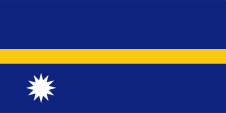
National flag,
ratio = 1:2,
Source, by: Flags of the World






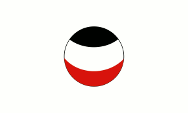
1888–1906,
Flag of the Jaluit Company,
Source, by: Wikipedia (DE)



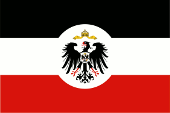
1888–1914,
German Empire,
official flag of Colonial Office / Foreign Office,
ratio = 2:3,
Source, by: Flags of the World





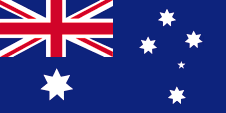
1920–1942, 1945–1968,
Flag of Australia,
ratio = 1:2,
Source, by: Flags of the World





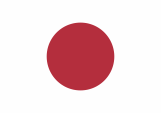
1942–1945,
Flag of Japan,
ratio = 7:10,
Source, by: Wikipedia (EN)




The on 31st of January in 1968 (day of the attainment of independence) introduced flag shows on a blue field a horizontal yellow stripe in the middle, as well in the left lower half a twelve-pointed white star. The flag expresses in this way the geographic position of the state. It is situated closely underneath the equator and western of the international date-line. The twelve-pointed white star stands for the twelve tribes of Nauru, but meanwhile two out of them are extincted. The colours of the flag seem to be defined today as follows: blue = Pantone 280, yellow = Pantone 123.
Source:
Flaggen Wappen Hymnen, Wikipedia (D)


Coat of arms of Nauru,
Source: Princeaus, Public domain,
via Wikimedia Commons

The coat of arms of Nauru shows on a by palm-tree-whisks surrounded shield the old alchemic symbol for phosphorus in the top half, phosphates were the economic wealth of the land. In the lower half a frigate-bird and a twig of Tomano blossoms. Above the shield, under a band with the name of the country, appears the twelve-pointed star, symbolising the twelve tribes of Nauru. Below the shield appears a banner with the country's motto: "Gods will first".
Source:
Flaggen Wappen Hymnen, Wikipedia (D)

Location:
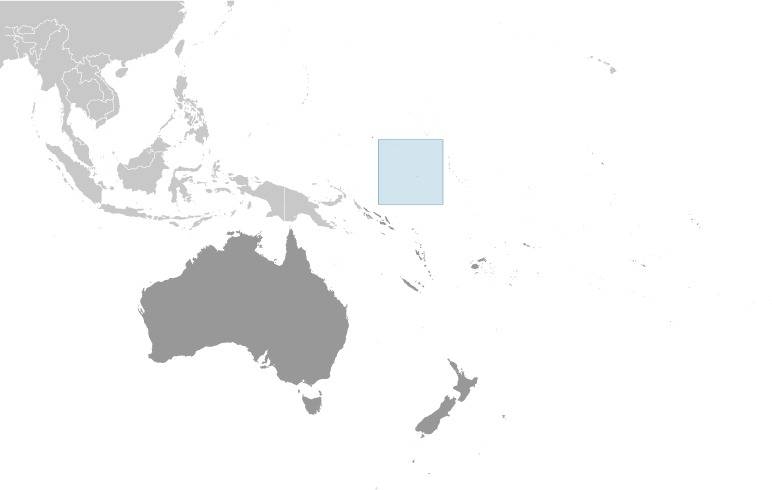
Source: CIA World Factbook
Map of the country:
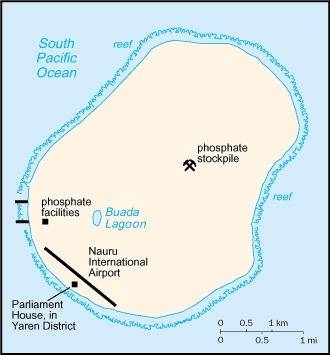
Source: CIA World Factbook

Area: 8,1 square miles
Inhabitants: 11.550 (2019), thereof 95% Nauruans, 3% other Oceanians
Religions: 60% Protestant, 33% Roman Catholic
Density of Population: 1.424 inh./sq.mi.
Capital: Yaren, 810 inh. (2019)
official Languages: English, Nauruan
Currency: Australian currency
Time Zone: GMT + 12 h
Source:
Wikipedia (D)

1798 · dicovery of the by Polynesians inhabited Island, in the following years occasional private colonization by the British
1830 · British settle
1878 · start of a tribal war that will cost the lives of a third of the population
1886 · Treaty of Berlin, the German Empire and United Kingdom settle the division of their spheres of interest in the Western Pacific, Nauru becomes a German area of interest
2nd of October 1888 · the German Empire establishes its protectorate over Nauru and ends the tribal war, Nauru becomes part of the Marshall-Islands, the local administration is carried out by the German Jaluit Society
1899 · start of the Christian Mission
1906 · the Marshall Islands (incl. Nauru) become affiliated as District of Jap with the colony of German New Guinea
1914 · First World War, British and Australian troops occupy Kaiser-Wilhelm-Land
1920 · Versailles Dictate, the German Empire loses all its colonies, Nauru (like the whole Kaiser-Wilhelm-Land) becomes a Mandate Territory of the League of Nations under Australian mandate
1942–45 · Second World War, occupation by Japanese troops
1945 · Australia occupys Nauru again
1947 · the mandate's administration of the League of Nations ends, Nauru gets further administrated as a Trust Territory of the UN by Australia
31st of January 1968 · independence
1st of May 1999 · Nauru becomes a full member of the Commonwealth of Nations
Source:
Atlas zur Geschichte,
World Statesmen,
Wikipedia (D)

The origin of the word "Nauru" is unknown. The Nauruans name their island then like today "Naoero". The word "Nauru" was later created out of "Naoero", to facilitate the speaking of the name of the island for Europeans and Americans. The island had further names in the past: the English colonists before 1888 named it "Pleasant Island" or "Shank Island", the German colonial sovereigns "Nawodo" or "Onawero".
Source: Wikipedia (D)


![]()




















